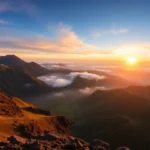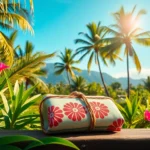Introduction to Mount Rinjani: Indonesia’s Most Iconic Volcano
Perched majestically on the island of Lombok in Indonesia, Mount Rinjani stands as a testament to the island’s volcanic heritage and natural grandeur. As Indonesia’s second-highest volcano, Rinjani boasts a complex history intertwined with geological activity, cultural significance, and adventurous tourism. Its towering presence and legendary status draw thousands of trekkers, nature enthusiasts, and cultural explorers each year, eager to experience its breathtaking vistas and rich biodiversity. Whether you are a seasoned hiker or a curious traveler, understanding the essence of Rinjani is vital to appreciating its significance and preparing for an unforgettable journey.
Historical Significance and Geology of Rinjani
Rinjani’s history is marked by dramatic volcanic eruptions and profound geological transformations. Originating from a caldera system, the mountain was formed over thousands of years through explosive eruptions and lava flows. Notably, the eruption of the volcano’s ancestor, the Samalas volcano, in 1257 AD, was one of the most powerful eruptions in history. This event not only reshaped the landscape but also had global climatic impacts, contributing to a temporary cooling of the planet’s temperature.
The current active volcano features a summit crater that measures approximately 2,400 meters in diameter, housing the spectacular Segara Anak Crater Lake, renowned for its emerald hues and volcanic activity beneath the surface. Geologically, Rinjani remains active, with periodic eruptions and geothermal activity that continually shape its terrain. Its geological features provide crucial insights into the Earth’s volcanic processes, making it a natural laboratory for scientists and researchers worldwide.
Location and Geographical Features of Mount Rinjani
Strategically located in North Lombok, Rinjani spans an area of roughly 41,300 hectares within the Rinjani National Park. The mountain’s elevation reaches 3,726 meters above sea level, making it the second-tallest volcano in Indonesia after Mount Kerinci. Its rugged terrain comprises lush forests, alpine grasslands, and volcanic craters that provide a stunning contrast against the surrounding tropical landscape.
The mountain is part of a larger bio-geographical transition zone known as Wallacea, which hosts diverse flora and fauna endemic to the region. The terrain features steep slopes, volcanic ridges, and the iconic caldera that encloses the central crater lake, Segara Anak. The area’s climatic conditions vary with altitude, ranging from humid tropical lowlands to cold, windswept highlands, offering a diverse ecological tapestry.
Why Rinjani Is a Must-Visit Natural Wonder
Mount Rinjani’s allure extends beyond its staggering height and geological complexity. It encapsulates a profound sense of adventure and spiritual awakening, making it a must-visit destination for explorers seeking more than just sightseeing. Its dramatic vistas—ranging from cloud-topped peaks to the serene crater lake—are truly otherworldly. The mountain’s biodiversity, including rare orchids, exotic birds, and unique wildlife, enhances its value as a natural sanctuary.
Furthermore, Rinjani holds cultural significance for local Sasak and Lombok communities, woven into their myths and traditional practices. The mountain’s majestic presence symbolizes strength and resilience, inspiring countless visitors to climb, reflect, and connect with nature’s raw power. For eco-tourists and trekker enthusiasts, Rinjani offers a challenging yet rewarding experience that tests endurance while providing a gateway to Indonesia’s vibrant natural and cultural heritage.
Planning Your Trekking Adventure on Mount Rinjani
Best Seasons and Conditions for Rinjani Hiking
Effective planning is crucial to ensuring a safe and enjoyable trek up Rinjani. The most favorable periods for hiking are during the dry season, typically April to October, when weather conditions are markedly more stable. During this window, hikers encounter less rain, clearer skies, and more predictable temperatures, all of which contribute to safer and more comfortable ascents.
The wet season, from November to March, introduces heavy rainfall, muddy trails, and potential landslides, increasing the risks associated with trekking. Additionally, conditions during monsoon seasons can lead to unpredictable volcanic activity, making trekking hazardous. Always check recent weather updates and volcanic activity reports before starting your journey, as Indonesia’s volcanoes are inherently active and require cautious planning.
Essential Gear and Preparation Tips for Climbers
Preparedness determines the success and safety of your Rinjani trek. Essential equipment includes sturdy hiking boots, layered clothing to cope with temperature fluctuations, and windproof and waterproof jackets. A reliable sleeping bag, headlamp, and durable backpack are also vital for overnight hikes.
Other gear includes high-protein snacks, plenty of water, a first aid kit, and sun protection items such as sunscreen and sunglasses. Altitude sickness can affect some trekkers, so carrying medication and acclimatization strategies is recommended. Physical training prior to the trek—focusing on cardio, strength, and stamina—is essential to endure the challenging ascent and descent.
Choosing Guided Tours and Safety Considerations
Given the difficulty and potential hazards of climbing Rinjani, guided tours are highly recommended, especially for first-time trekkers. Reputable local and international companies offer packages that include permits, experienced guides, porters, and safety equipment. Guides are trained to navigate the terrain, handle emergencies, and provide cultural insights.
Safety considerations include briefing on volcanic activity alerts, checking weather conditions, and ensuring all participants have proper gear. Always inform someone about your itinerary, stick to established trails, and adhere to park regulations to minimize risk. Emergency communication devices, such as satellite phones or GPS trackers, are also prudent additions for remote areas.
Highlights and Attractions of Mount Rinjani
The Summit View and Crater Lake
The summit of Rinjani offers panoramic vistas that leave visitors awestruck. Standing at its peak, trekkers can gaze over the expansive island landscape, neighboring islands, and, on clear days, even distant volcanic peaks. The iconic Segara Anak Crater Lake, nestled within the caldera, boasts shimmering emerald waters and geothermal hot springs. Watching the sunrise from the summit encapsulates the essence of adventure and achievement, providing an unforgettable experience that embodies the spirit of exploration.
Rinjani Waterfalls and Nearby Hot Springs
The region surrounding Rinjani is rich with waterfalls and natural hot springs. Popular attractions include Sendang Gile and Tiu Kelep waterfalls, which cascade through lush forests and provide refreshing respite for trekkers. The hot springs near Segara Anak Crater are not only geothermal wonders but also sanctuaries for relaxation after rigorous climbs—soaking in these mineral-rich waters offers both physical relief and cultural immersion.
Flora, Fauna, and Unique Biodiversity
The ecological diversity of Rinjani National Park is remarkable. Its forests are home to rare orchids, ferns, and towering trees, while its fauna includes the Lombok monkey, various bird species, and insects endemic to Wallacea. The park’s unique bio-geographical transition zone fosters a rich tapestry of life that attracts scientists and nature enthusiasts alike. Conservation efforts focus on protecting this biodiversity, emphasizing the importance of sustainable tourism practices to preserve Rinjani’s ecological integrity.
Connecting With Local Culture and Eco-Tourism Initiatives
Traditional Villages and Cultural Lessons
Interacting with local communities enriches the Rinjani trekking experience. Villages like Sembalun Lawang and Senaru serve as cultural hubs, offering insights into Sasak traditions, crafts, and spiritual beliefs. Participating in traditional rituals or learning about local weaving, music, and dance fosters a deeper appreciation for Lombok’s cultural heritage. Respectful engagement and supporting local artisans help sustain the community’s way of life.
Sustainable Tourism and Park Conservation Efforts
To preserve Rinjani’s pristine environment, sustainable tourism initiatives promote responsible travel. These include waste management programs, limiting group sizes, and encouraging eco-friendly accommodations. The national park authorities work diligently to restore damaged ecosystems, control illegal activities, and educate visitors on minimizing their ecological footprint. Visitors are urged to follow park rules, avoid littering, and respect wildlife to ensure the mountain remains a vibrant natural wonder for future generations.
Tips for Respectful Travel and Community Support
Travelers should approach their visit with cultural sensitivity and environmental awareness. Supporting local businesses, purchasing authentic crafts, and participating in community-led tours promote equitable economic growth. Dressing modestly, seeking permission before photography of locals, and engaging with sincerity help foster respectful relationships. Remember, responsible tourism is the key to conserving the cultural and natural integrity of Rinjani and its surrounding villages.
Performance Metrics and FAQs About Mount Rinjani
Visitor Statistics and Popularity Indicators
Mount Rinjani ranks among Indonesia’s top adventure destinations, with annual visitor numbers exceeding 20,000 for the trekking season. Its popularity surged after the recognition of the national park and documented successes of high-profile climbs such as the Rinjani Ultra Challenge and Rinjani Mountain Run. The increasing number of guided tours, eco-conscious initiatives, and social media exposure further attest to Rinjani’s status as a world-renowned natural landmark.
Frequently Asked Questions (FAQs) for Trekking and Safety
- How long is the typical Rinjani trek?
- The trek usually covers approximately 27 to 40 km, depending on the route and pace, with durations ranging from 2 to 4 days.
- What is the best time to climb Rinjani?
- The dry season, from April to October, offers optimal conditions for safety and comfort.
- Are permits required for climbing?
- Yes, climbers must obtain permits from the park authorities; guided tours often handle this process.
- Is altitude sickness common?
- While not universal, some trekkers experience mild symptoms—proper acclimatization and hydration are recommended.
- What safety measures should I take?
- Follow guide instructions, monitor volcanic activity updates, and carry emergency communication and first aid supplies.
Latest News on Rinjani Volcanic Activity and Eruption Alerts
The Indonesian volcanic agency continuously monitors Rinjani’s activity. Recent reports indicate a quiescent period, but alerts remain in place due to the volcano’s active status. Climbers are advised to stay informed through official channels and avoid the mountain during heightened activity or adverse weather conditions. Preparedness and adherence to safety advisories are essential for a secure visit.





